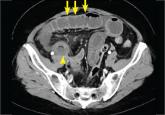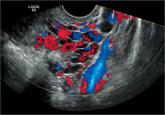Applied Evidence

RADIOLOGY REPORT: An imaging guide to abdominal pain
When patients present with acute nontraumatic abdominal pain, knowing what disorders and which imaging modalities to consider is essential. Let...
Guy N. Gibson, DO
Dell P. Dunn, MD
Diagnostic Imaging, Ehrling Bergquist Clinic, Offutt Air Force Base, Neb (Dr. Gibson); Abdominal Imaging, David Grant Medical Center, Travis Air Force Base, Calif (Dr. Dunn)
guy.gibson.1@us.af.mil
The authors reported no potential conflict of interest relevant to this article. The views expressed here are those of the authors and do not reflect the official policy of the Department of the Air Force, the Department of Defense, or the US government.
Click here to view RADIOLOGY REPORT: An imaging guide to abdominal pain
Click here to view RADIOLOGY REPORT: 2 cases to test your skills

1. Ask yourself the following before you order that test:
• Will imaging change management?
• Are there previous imaging results that provide diagnostic management information?
• Can the same information be obtained without exposure to ionizing radiation?
2. Call the radiologist to clarify the best initial imaging exam to answer a particular clinical question. A brief discussion of a patient’s presentation, initial work-up, and differential considerations will help the radiologist to ensure that he or she is performing the right exam to help guide management. Such initial discussions can reduce unnecessary, incorrect, or repeated exams and in some cases, may help to determine if a referral to a tertiary care center would be more appropriate.
3. Take into account available technology and patient allergies to determine the most expedient, efficacious exam to answer the clinical question.
Atopic individuals (particularly those with multiple severe allergies) and those with asthma are at heightened risk for allergic-like contrast reactions. 1 A history of a prior allergic-like reaction to contrast is the most substantial risk factor for a recurrent adverse allergic reaction. 1 In cases of prior contrast reaction, and when the benefits outweigh the risks, consider a pre-medication routine.
4. Provide the radiologist with a thorough history, which should include surgeries and pertinent laboratory values. Knowing the type of surgery a patient had and how recent it was will help guide the radiologist in evaluating for specific complications. For example, if a patient has had a recent laparoscopic cholecystectomy, complications can include bile leak, infection/abscess, hemorrhage, and intestinal injury.
Knowing this information will help avoid misinterpreting a small amount of expected free air or inflammatory change from acute bowel perforation with early phlegmon/abscess formation.
Similarly, it is vital for the radiologist to know if the patient being evaluated for right flank pain is febrile or has an elevated white blood cell count as an obstructed kidney that is infected may require emergent percutaneous drainage. On the other hand, an obstructed kidney without infection can, in most cases, be managed expectantly.
5. Include good provider contact information in the imaging request so any emergent findings can be readily communicated. Too few requests include provider contact information and when provided, it often leads to a time-consuming phone tree (or is outdated).
Routine exams should include the direct line of the clinic, receptionist, or provider’s desk. All emergent exams should include a current pager or cell phone number where the ordering physician or team can be reached directly.
6. Increase your knowledge of incidental findings and how to manage them. A good resource, “Managing incidental findings on abdominal CT: white paper of the ACR Incidental Findings Committee,” can be found at http://www.jacr.org/article/S1546-1440(10)00330-3/fulltext.

When patients present with acute nontraumatic abdominal pain, knowing what disorders and which imaging modalities to consider is essential. Let...

